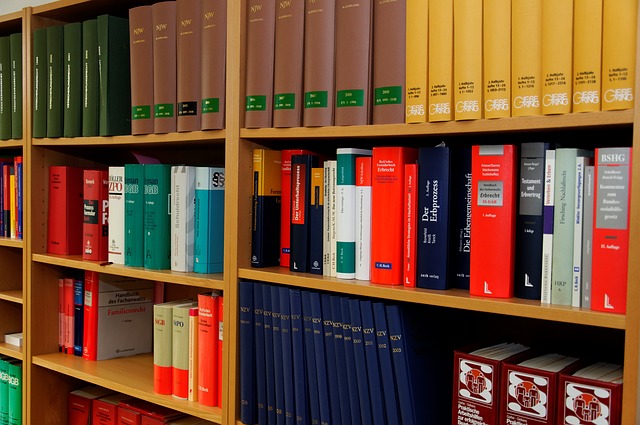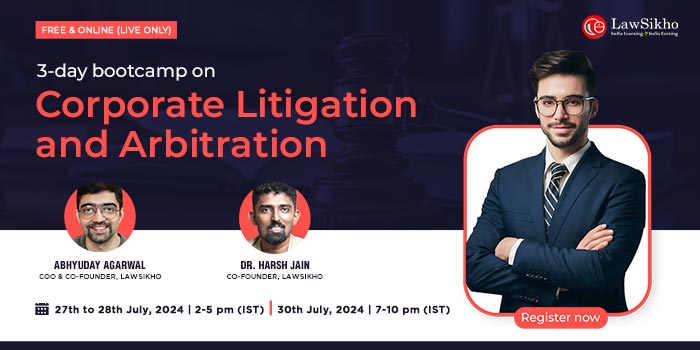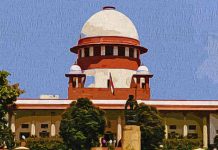This article has been written by Upasana Sarkar. In this article, the landmark judgement of Kesavananda Bharati v. State of Kerala has been discussed. This article gives a detailed understanding and an extensive analysis of this case. It also deals with other landmark judgements related to this case as well as recent judgements, highlighting the importance of the basic structure doctrine. It is the first case to limit the amending power of the legislature under Article 368 of the Constitution.
This article has been published by Shashwat Kaushik.
Table of Contents
Introduction
Keshvananda Bharati v. State of Kerala (1973) was the first case that established the basic structure doctrine. It states that the legislative bodies must follow this doctrine while exercising their amending powers. Though they are given the power to amend any part of the Constitution, they are not allowed to amend the basic structure under Article 368 of the Indian Constitution. It is one of the most landmark cases, where the Supreme Court formed a bench of thirteen judges to make a decision in this matter. This decision of the judges, till now, has a major impact in our society. It is a unique and thoughtful judgement passed by the Supreme Court. The judgement passed by the bench was approximately 700 pages long and included a solution for both Parliament’s right to modify laws under Article 368 and citizens’ right to safeguard their fundamental rights. The Kesavananda Bharati case is so important because it was the first case that came up with the doctrine of basic structure in order to safeguard the interests of both the citizens as well as the Parliament. Through this judgement, the Bench addressed the questions that were left unanswered in the case of Golaknath’. This case overruled the decision that was given in the Golaknath v. State of Punjab (1967) case by imposing certain limitations on the Parliament’s amending power. Though this case states that any part of the Constitution can be amended under Article 368 by the Parliament but certain restrictions are imposed on them. They do not have unlimited power to amend it. The doctrine of basic structure was introduced to ensure that the amendments do not infringe upon the basic rights of the citizens, which were guaranteed to them by the fundamental rights.
Historical background of Kesavananda Bharati v. State of Kerala (1973)
In India, the three main branches of government function autonomously, each fulfilling their distinct roles. While the legislature and executive collaborate closely, the Indian judiciary is deliberately maintained as an independent entity. The legislature makes laws, the executive enforces those laws, and the judiciary adjudicates those laws. In the beginning of the 1970s, India witnessed a clash between two major powers, the legislature and the judiciary. This led to this landmark judgement of Kesavananda Bharati v. State of Kerala case.
The Supreme Court of India passed a historic judgement that is useful in determining the powers of the three democratic government institutions. It took nearly five months to pass a decision in this case. This case preserved the dignity and integrity of the Indian Constitution. It set a basic structure doctrine for all the high courts and district courts in India.
Before the 44th Amendment of the Constitution, the right to property was considered a fundamental right. At that time, the Zamindars filed petitions in various high courts stating that their fundamental rights were being violated by the enactment of agrarian land reform laws. The High Court of Patna upheld the Bihar Land Reforms Act, 1950. After the enactment of this Act, the Constituent Assembly passed the 1st Amendment to the Constitution of India in 1951, which protected land reform laws from judicial review. Article 31B, which was added to the 9th Schedule, states that laws cannot be challenged on the ground that they violate fundamental rights. The doctrine of basic structure emerged from the following landmark cases:
Shankari Prasad v. Union of India
In the case of Shankari Prasad v. Union of India (1951), the Zamindars filed a suit against the 1st Amendment of the Constitution, which included amendments under Article 13(2) of the Constitution that prevented the Indian Parliament from making a law that could take away fundamental rights. The five bench judges of the Supreme Court dismissed the petition, stating that the courts cannot review constitutional amendments and that Article 13 is limited to ordinary laws only. The Supreme Court observed that Article 368 of the Indian Constitution empowers the Parliament to amend the Constitution, including fundamental rights.
This case helped in the addition of Article 31A and Article 31B that were included to enable land reform measures that were previously not possible due to the presence of the right to property provision under Part III of the Constitution. The Apex Court observed that Article 13 only includes ordinary laws and not amendments to the Constitution, which are made in the exercise of constituent power. So it is not subjected to judicial review.
Sajjan Singh v. State of Rajasthan
In the case of Singh v. State of Rajasthan (1965), the constitutional validity of the 17th Amendment of the Constitution that was passed in 1964 was challenged. This amendment added 44 additional provisions to the 9th Schedule of the Constitution. The petitioner contended that this amendment was infringing on fundamental rights as it was not made using the correct method. Though the opinions of the judges differed, Justice Mudholkar expressed his opinions regarding certain reservations that are necessary about the basic structure doctrine.
The Supreme Court dismissed the petition, stating that Parliament has unlimited power to pass an amendment under Article 368 of the Constitution. The Supreme Court confirmed the judgement passed in the Shankari Prasad case and held that Parliament can amend any part of the Constitution, including fundamental rights.
Golaknath v. State of Punjab
In the case of I. C. Golaknath v. State of Punjab (1967), the question raised was whether the Parliament has the power to amend the fundamental rights of the citizens of India. The landlords challenged the constitutional validity of the First, Fourth, and Seventeenth Amendments passed by the Parliament. An eleven-judge bench was set up to review the issue of the constitutional validity of these amendments and whether the Legislature has been empowered to amend fundamental rights. This judgement was passed by a majority of six judges, stating that the Parliament had no power to amend Part III of the Constitution to take away or abridge fundamental rights. This judgement curbed Parliament’s power to amend any fundamental rights under Part III of the Constitution. The judgement passed in this case overruled the judgement of Shankari Prasad v. Union of India. The viewpoint of Golaknath’s judgement was not accepted by many of the legal experts in the country.
There was an assertion that Article 368 of the Constitution included the substantive power of change in addition to dealing with the amendment process. This judgement was followed in a few cases until it was challenged in the landmark case of Kesavananda Bharati v. State of Kerala. This view was changed in this case, and it was held that Article 368 gives the Parliament the authority to change any provision of the Constitution, including Article 368 itself. But it also included certain limitations which said “essential features” of the constitution could not be altered or removed. The following amendments were made after the Golaknath’s case, which was challenged in the present case:
24th Amendment
- In the case of Golaknath, the Supreme Court held that the judgement that every amendment made under Article 368 will be taken as an exception under Article 13. Therefore, in order to neutralise this effect, the Parliament, through an amendment to Article 13 of the Constitution, annexed clause 4, which states that laws implementing the directive principles of state policy may be passed by the government, even if they contradict or violate the fundamental rights of the Constitution, so that no amendment can have an effect under Article 13.
- The Parliament, in order to remove any kind of ambiguity, added clause 3 to Article 368, which reads as follows: “Nothing in Article 13 shall apply to any amendment made under this article.”
- The Supreme Court in the Golaknath case observed that Article 368 originally had a provision that granted the procedure of amendment rather than the authority. Therefore, Article 368 was modified by the Court, and the word ‘power’ was put in the marginal note in order to incorporate the word power within the article. The 24th Amendment was passed to ensure that the President is left with no other choice to refuse or withhold a bill. This Amendment was passed by Parliament with the intention to safeguard their amending power from the exception that is mentioned under Article 13 of the Indian Constitution.
25th Amendment
Through the 25th Amendment, the Parliament clearly specified that they are not bound to adequately compensate the landlords in case their property is taken by the state government. To implement that provision, the word ‘compensation’ was replaced with the word ‘amount’ by the Parliament under Article 31(2) of the Constitution. Therefore, the link between Article 19(1)(f) and Article 31(2) was removed and this lead to the addition of a new provision. It was added under Article 31(c) of the Constitution so as to remove all difficulties and to fulfil the objectives laid down under Article 39(b) and Article 39(c). It was decided that Article 14, Article 19, and Article 31 would not apply to any law. To bring Article 39(b) and Article 39(c) into effect, the court was immunised from intervening in any law made by the Parliament.
29th Amendment
The 29th Amendment was passed in 1972, which introduced the Kerala Land Reforms Act (1963) into the 9th Schedule. This Act stated that the matters related to the Kerala Land Reforms Act would be outside the scope of the judiciary to try. This was included in the 9th Schedule purposely to keep the matter out of the hands of the Judiciary. All the amendments that were made by the Central Government in some way protected the amendments made by the State Government from being tried in a court of law. So in the Kesavananda Bharati case, these provisions of the Kerala Land Reforms Act, along with the 24th, 25th, and 29th Amendments, were challenged in the court of law.
Identification of parties
Petitioner: Kesavananda Bharati and Others
Respondent: State of Kerala
Bench: S.M. Sikri, K.S. Hegde, A.K. Mukherjea, J.M. Shelat, A.N. Grover, P. Jaganmohan Reddy, H.R. Khanna, A.N. Ray, K.K. Mathew, M.H. Beg, S.N. Dwivedi, & Y.V. Chandrachud.
Summary of facts in Kesavananda Bharati v. State of Kerala (1973)
Keshvananda Bharati, the petitioner in this case, was the chief of the Edneer Mutt, which belonged to a religious sect in the Kasaragod district of Kerala. Kesavananda Bharati had certain pieces of land in the sect that were purchased in his name. Therefore, he was the owner of that land. The State Government of Kerala introduced the Land Reforms Amendment Act in 1969, according to which the government was entitled to acquire some of the sect’s land, of which Kesavananda Bharati was the chief. Kesavananda Bharati filed the suit in the Supreme Court on 21st March, 1970, under Article 32 of the Indian Constitution for enforcement of his rights, which are guaranteed under Article 25 (right to practise and propagate religion), Article 26 (right to manage religious affairs), Article 14 (right to equality), Article 19(1)(f) (freedom to acquire property), and Article 31 (compulsory acquisition of property). When the petition was still under consideration by the court, the Kerala government passed another act, i.e., the Kerala Land Reforms (Amendment) Act, 1971.
Issues before the court
- Whether the Constitutional Amendment can be applied to fundamental rights as per Article 368 of the Constitution?
- Whether the 24th Constitutional (Amendment) Act, 1971, is constitutionally valid or not?
- Whether the 25th Constitutional (Amendment) Act, 1972, is constitutionally valid or not?
- Whether the 29th Constitutional (Amendment) Act is valid, and to what extent can Parliament exercise its power to amend the Constitution?
Contentions by parties on issues
Petitioner’s contentions
It was contended by the petitioner that the Parliament cannot amend the Constitution in whatever way they feel like. Unlimited power cannot be granted to them as there are chances of it being miused. The Parliament cannot exercise its power to amend the constitution by changing its basic structure which was earlier propounded by Justice Mudhokar in the case of Sajjan Singh v. State of Rajasthan. It was argued by him that the 24th and 25th Constitutional Amendments violated the Fundamental Right, which was provided under Article 19(1)(f) of the Indian Constitution. Some of the important points of the arguments are as follows:
- It was contended that Article 368 of the Constitution does not grant authority to change, amend, or abrogate the basic framework of the Constitution or the fundamental rights of the citizens.
- It was also contended that the term ‘amendment’ does not mean the fundamental identity or framework of the Constitution can be altered or destroyed while exercising the amending power.
- It was also argued that this amending power is granted by the Constitution itself and, therefore, is subjected to inherent limitations.
- It was also contended that the Parliament is not given the power to amend the fundamental rights of the citizens of India.
Respondent’s contentions
The respondent was the state in this case. It was contended that the supremacy of Parliament is the basic principle of the Indian legal system, and therefore, Parliament has the power to amend the Constitution without any limitations. Some of the important points of the arguments are as follows:
- The foremost contention made by the respondent was that Parliament is vested with unlimited amending power to amend any part of the Constitution without any kind of exception. This power is conferred on Parliament in accordance with the provisions of Article 368 of the Constitution.
- It was also contended that the term ‘amendment’ means that Article 368 of the Constitution can be used to add, alter, modify, repeal, or abrogate any part of the Constitution.
- Another argument made by the state was that there is no other inherent limitation to the amending power other than the procedural as laid down in Article 368.
- It was also contended that the Indian Parliament is entrusted with the power to amend the fundamental rights by abrogating or abolishing them if they think it is necessary to do so by exercising its constituent power.
- It was also stated that the members of the Parliament are elected by the people of India and therefore, can modify the fundamental laws according to the needs of the citizens.
Ratio decidendi of Kesavananda Bharati v. State of Kerala (1973)
- Chief Justice S.M. Sikri, Justice K.S. Hegde, Justice J.M. Shelat, Justice Jaganmohan Reddy, Justice A.N. Grover, Justice Hans Raj Khanna, and Justice B.K. Mukherjea held the majority view, stating that the power to amend the Constitution does not mean that the basic structure of the Constitution can also be amended. It was held that the basic framework of the Constitution must not be affected while amending any part of the Constitution.
- Justice Y. V. Chandrachud, Justice D.G. Palekar, Justice A.N. Ray, Justice M.H. Beg, Justice K.K. Mathew, and Justice SN Dwivedi stated that Article 368 has the capacity to introduce, amend, or remove any articles of the Constitution, aside from those that deal with fundamental rights. This power encompasses the introduction, modification, and deletion of any or all of the articles of the Constitution, with the exception of those that deal with basic rights.
- Apart from the above views, Justice Khanna observed that the unlimited power to amend is not applicable to changing the basic structure of the Constitution.
- Justice Mathew and Justice Ray concluded by agreeing with the notion of plenary rights. According to them, the Indian Constitution cannot be entirely repealed, creating a constitutionally void situation. They contended that the reforms must provide for the existence of government mechanisms in place for the creation, development, interpretation, and enforcement of laws.
Judgment in Kesavananda Bharati v. State of Kerala (1973)
The decision of the Kesavananda Bharati case was passed on 24th April, 1973, by a slight majority of 7:6, where seven of the judges were in favour of the view that the Indian Constitution is amenable like other Acts and statutes. It was permitted by the judges so as to fulfill the socio-economic obligations of the State that are given to the citizens of India. The fundamental rights are granted to them and those rights can never be changed by the Parliament by amending any of them. The basic structure must remain the same. Six of the judges, the minority, who were against this judgement were of the opinion that the Parliament must not be vested with the unlimited power of amending the Constitution.
The landmark case was decided on 24th April 1973 where the judgement was delivered by S.M. Sikri CJI, K.S. Hegde, B.K. Mukherjea, J.M. Shelat, A.N. Grover, P. Jagmohan Reddy JJ, and Khanna J. Whereas, the minority opinions were written by A.N. Ray, D.G. Palekar, K.K. Mathew, M.H. Beg, S.N. Dwivedi, and Y.V. Chandrachud J. The dissenting judgement was given by other judges, who were still reluctant to give unfettered authority to Parliament. The court upheld the constitutionality of the 24th Amendment entirely. But in the case of 25th Amendment, the 1st and 2nd parts were found to be intra vires and ultra vires, respectively. The Court, therefore, answered all those questions that were previously left unanswered in the case of Golaknath in relation to the powers of the Parliament to amend the Constitution. The answer to the question was found in this Kesavananda Bharati case, where the court observed that the Parliament has the power to amend the Constitution to the extent that such amendment does not change the basic structure of the Indian Constitution. It was laid down by the court that the doctrine of basic structure is to be followed by the Parliament while amending the provisions of the Constitution.
Critical Analysis of the judgement in Kesavananda Bharati v. State of Kerala (1973)
In Kesavananda Bharati case, the majority of the bench wanted to preserve the Indian Constitution by protecting its basic features. So they decided not to provide unlimited power to amend the Constitution as it can be misused by the government in future. It provided stability to the Constitution. Though the petitioner lost his case partially, the judgement that was given by the bench in this case worked out to be a saviour of Indian democracy and saved the Constitution from losing its spirit.
This case played an important role in re-evaluating the decisions that were made in the cases of Shankari Prasad v. Union of India, Sajjan Singh v. State of Rajasthan, and Golaknath v. State of Punjab. The Supreme Court observed that the Parliament has the power to amend the Constitution under Article 368, including Part III, which deals with the fundamental rights of citizens. Therefore, it was held that any part of the Indian Constitution can be amended, but the basic framework of the Constitution must not be affected. This upheld the doctrine of basic structure.
The judges of the Supreme Court gave their opinion regarding those parts that must be included in the basic structure and must not be changed while amending any part of the Constitution. Justice Sikri, who was the Chief Justice of India at the time, stated the following features as the basic structure of the Constitution that must not be changed:
- The Supremacy of the Constitution,
- Separation of the three major government institutions; legislature, executive, and judiciary,
- The federal nature of the Constitution,
- The secular nature of the Constitution,
- The democratic form of government and its republican form.
Justice Grover, Justice Mukherjea, Justice Hegde, Justice Reddy, and Justice Shelat also added some more features to the basic structure of the Constitution, which are as follows:
- The unity and integrity of the nation must be maintained.
- The freedom of individuals must be protected.
- The sovereignty of the nation must be upheld.
- Parliamentary democracy must be preserved.
- An egalitarian society must be formed.
- The dignity of individuals must be preserved, which is granted by fundamental rights, and a welfare state must be built in accordance with the Directive Principles of State Policy.
The judges of the Supreme Court were not unanimous in bringing forward a fixed basic structure, but they succeeded in safeguarding the spirit of Indian democracy. This case succeeded in extending the scope of judicial review. The Apex Court, after this case, had the authority to both review and refute any amendment that is made in violation of the basic framework of the Constitution as a limitation to the Parliament’s unrestricted right to amend the Constitution. Therefore, the Supreme Court of India has the unfettered power to review the Constitution and assert its supremacy in interpreting the Constitution.
Implications of the judgement in Kesavananda Bharati v. State of Kerala (1973)
In the case of Indira Nehru Gandhi v. Raj Narain (1975), Clause (4) of Article 329-A of the 39th Amendment Act was struck down by the Supreme Court, which provided that the election issues of the Prime Minister and the Speaker of Lok Sabha should be kept outside the jurisdiction of all courts. The Supreme Court stated that this provision alters the basic framework and structure of the Constitution, and therefore, Parliament has no authority to amend it.
In the case of Minerva Mills v. Union of India (1980), the doctrine of basic structure was upheld by the Supreme Court. This landmark judgement is well known because of the addition of two new features to the list of basic structure doctrine. Firstly, the feature of judicial review was introduced, and secondly, a balance between fundamental rights and directive principles was made. It was stated by the Supreme Court that the Parliament is permitted to amend the fundamental rights for the implementation of the directive principles so long as the amendment does not destroy or hamper the basic structure of the Constitution.
In the case of Waman Rao and Ors. v. Union of India (1980), a suit was filed in the Bombay High Court challenging the reduced agricultural land holdings limit under the Maharashtra Agricultural Lands (Ceiling on Holdings) Act, 1961, along with certain other amendments that were passed. The petitioner filed the petition when the government of Maharashtra imposed a ceiling on agricultural holdings. This petition was filed during the emergency period. Articles 14 and 19 could not be enforced during that time of emergency. The constitutional validity of Article 31A, which deals with land acquisition provisions, and Article 31B, which is related to the validation of law and provides immunity to laws from judicial review, were challenged, and the Court observed their constitutional validity.
The judgement passed by the Supreme Court was that an act violating fundamental rights does not mean that it is also violating the basic structure doctrine. Both concepts are totally different. An act violating the fundamental rights under Part III does not mean it is also damaging the basic structure doctrine of the Constitution. The Apex Court also stated that orders passed before the introduction of the basic structure doctrine would remain valid. So as a result, it was decided in the Kesavananda Bharati case that all the acts and regulations that were passed after April 24, 1973, falling under the 9th schedule of the Indian Constitution will be included. In any case where the regulations fail to meet the requirements of the test or the established parameters or grounds, they will be removed from the schedule through the judicial review process.
In the case of S.R. Bommai v. Union of India (1994), a writ petition was filed by the Karnataka Chief Minister, S.R. Bommai, when his Janta Dal was dissolved on the ground of lack of majority support and the Presidential rule was imposed under Article 356 of the Constitution. In this case, the petitioner requested the governor to do a thorough investigation and floor test to review the party’s majority. The governor rejected his idea, and he failed to prove his majority. So he went to the Karnataka High Court and filed a writ petition against the decision of the Governor. However, the Karnataka High Court dismissed his petition. He then approached the Supreme Court and filed an appeal in which he stated that the removal of his government was merely a political strategy and that the imposition of presidential rule was mala fide, as there was no bona fide reason for doing it.
The Supreme Court passed a landmark judgement stating some of the important points that need to be followed in the future, which are as follows:
- The power to impose the President’s rule in a state is not absolute, and it will need the prior approval of both Houses of Parliament.
- The power to remove the government of a state by the president is not absolute. It should be done after getting the consent from both houses.
- The President is only permitted to suspend the Legislative Assembly for the time being.
- If the Houses of Parliament do not approve the proclamation, it will lapse after a period of two months, and the dismissed government will be revived. The suspension of the Legislative Assembly will also come to an end.
It was also stated by the Apex Court that the proclamation of the imposition of President’s rule under Article 356 of the Constitution will be subjected to judicial review so that no party is prejudiced. The judgement also stated that the test of majority must be done properly on the floor of the Assembly, and the Governor cannot give his opinion on this matter. The Supreme Court observed that if any actions taken by a state government go against a fundamental component of the Constitution, then the federal government has been granted the right to exercise its authority under Article 356. Following the demolition of the Babri Masjid, the Supreme Court employed the principle of “secularism,” a fundamental term in the Preamble, to justify the application of Article 356. This case stands as a landmark example where the Court invoked ‘secularism,’ an integral aspect of the basic structure doctrine.
In the case of I.R. Coelho v. State of Tamil Nadu (2007), a unanimous decision was taken by a nine judge bench, which has been led by Chief Justice Sabharwal. Some of the laws that were previously found to be arbitrary and unconstitutional in nature were added to the Ninth Schedule of the Constitution. Some of the Acts like Section 2(c) of the West Bengal Land Holding Revenue Act, 1979, and Gudalur Janmam Estates (Abolition and Conversion into Ryotwari) Act, 1969, were added by the 66th Amendment in 1990. While dealing with this case, the Waman Rao case was referred to. In this case, the judges passed a majority judgement stating that laws that were added to the Ninth Schedule after 24th April, 1973, could be challenged if it is seen that the law is acting in violation of Articles 14, 19, 21, and other related principles. Thus, a nine judge bench was formed to determine and re-examine the judgement of Waman Rao’s case.
In this case, the Supreme Court emphasised on protecting the fundamental rights of citizens. It stated that the Constitution permits the legislature to exercise the amending power under Article 368 and not the Constituent Assembly. The Court also stated that any law that violates the basic structure of the Constitution must not be shielded. The Court also stated the grounds that will permit the legislature to escape scrutiny, which are as follows:
- It was stated that the basic structure is the core of the Indian Constitution. Therefore, any rules or regulations that are passed which violate the essence will not be tolerated, and they will be declared null and void.
- In case of an amendment, if any law is added to the Ninth Schedule that is inconsistent with the fundamental rights of the citizens, it will be struck down by the Court.
- The Ninth Schedule, being a part of the Constitution, cannot contain any provisions that violate Part III. Any changes made to a section of the Constitution must be made in accordance with the provisions, and any harmful pre-existing clauses must be removed.
- The intention behind adding provisions to the Ninth Schedule is probably to violate the fundamental rights of citizens. In order to safeguard those rights, it is necessary to consider removing those specific provisions from the Constitution to protect the inherent rights if any kinds of violations occur.
Importance of basic structure doctrine
The basic structure doctrine is a kind of judicial review that is used by the judiciary to determine the legality of a particular law. The importance of the basic structure doctrine is as follows:
- The fundamental principles and ideas of the Constitution are protected by the basic structure doctrine. It means that it safeguards ideas like separation of powers, the fundamental rights of citizens, and the rule of law. It places emphasis on the principle that the core concepts of the Constitution cannot be amended in a way that can compromise its essential ideas.
- Any arbitrary constitutional amendments passed by a political party are prohibited by the Judiciary with the help of this basic structure doctrine. It acts as an essential tool for keeping a check on the absolute amendment power of Parliament. Therefore, the ruling party cannot modify the Constitution at their will.
- The constitutional identity is preserved and maintained by the basic structure doctrine. It helps the Constitution to work in its true and original spirit.
- The flexibility and rigidity of the Constitution are balanced with the help of this basic structure theory. It preserves the core concepts of the Constitution without compromising the essential constitutional revisions. Hence, this doctrine of basic structure acts as a saviour of long-standing constitutional principles.
How were the directive principles of state policy applied in Kesavananda Bharati v. State of Kerala (1973)
In this case, the 25th Constitutional Amendment upheld certain provisions of directive principles of state policy, namely, Article 39(B) and (C), over certain fundamental rights like Articles 14, 19 and 31 of the Indian Constitution in the interest of social welfare and economic democracy. As a result, a new Article 31(C) was inserted, and clause 31(2(a)) was replaced by another clause, that is, clause 2(b). With this new amendment, the right to own property was restricted, and the government was permitted to purchase private land for public use in exchange for compensation that would be decided by Parliament rather than the courts. In addition to the alteration, the Court’s ability to conduct a judicial review of any relevant case was further reduced by the amendment made by Article 31(c) that lessens the Court’s ability to conduct a judicial review of any relevant matter.
Issues relating to basic structure doctrine
There are certain issues related to basic structure doctrine, which are as follows:
- The main issue in relation to basic structure doctrine is that there is no particular provision in the Constitution that specifies it has a basic structure beyond the competence of amending power.
- Another issue is that this concept of basic structure doctrine is against the tripartite structure of government, in which the three organs have been vested with different powers within a defined jurisdiction.
- Since the basic structure doctrine has not been defined in the Constitution, the judges of different high courts define it differently according to their subjective satisfaction.
- Another issue is that the courts can declare any law null and void if they think a particular law passed by Parliament is against the basic structure doctrine. The Judiciary has the power to impose their decision on the government that has been formed democratically by the citizens of India.
Conclusion
Kesavananda Bharati v. State of Kerala was one of the landmark cases that established Indian democracy and the basic structure doctrine. It is one of the important constitutional cases that safeguarded the fundamental rights of the citizens by stating that any amendment that is inconsistent with the fundamental rights will be declared null and void. In this way, the Indian Judiciary limited the amending power of the Legislature and established democracy. The majority of the judges in this case wished to protect the interests of the citizens by making fundamental rights non-amendable. This case also laid down some major and significant precedents for the interpretation of the Constitution. A bench of thirteen judges was set up to hear this case and reach a decision. The bench observed that if the Legislature is given the unfettered power to amend the Constitution, then that power could have been misused or arbitrarily used by the ruling party at their whims. Such limitless power would lead to arbitrariness and dictatorship, which would change the very essence and spirit of the Indian Constitution. In the cases of Golaknath, Shankari Prasad, and Sajjan Singh, the basic structure doctrine was not given importance. So in order to uphold democracy, the Indian judiciary, therefore, introduced a doctrine that preserved the rights of the citizens without being infringed upon by any political parties. Therefore, the basic structure doctrine also removes the fear of misuse or abuse of power by any political party. This case, therefore, portrayed that the Indian Judiciary is independent and is not at all influenced by any government. Thus, the constitutional values and foundation of the Constitution were strengthened by this judgement.
Frequently asked questions (FAQs)
What was the outcome of the Kesavananda Bharati case?
The conclusion of this case was that the Parliament can amend the Constitution whenever they think it is necessary, but as per the provision of Article 368, they can never change or modify the basic structure of the Constitution. There is a certain limitation to the Legislature’s amending power.
When was the case filled?
The petition was filed on 21st March, 1970, by Bharati against the violation of his three fundamental rights of the Constitution, that is, Article 24, Article 25, and Article 29.
What is this case about?
It was claimed by the petitioner that the Kerala Land Reforms (Amendment) Act, 1969, has infringed on his fundamental rights, like the right to property under Article 31, freedom of religious denomination under Article 26, and the right to worship and propagate religion under Article 25.
Why is this case so important?
This case is so important because the validity of the 24th, 25th, and 29th Amendments was challenged by the petitioner, who argued that these amendments are directly violating his fundamental rights. The seven judges opined that the Parliament has the power to amend the Constitution but not its basic structure. The Apex Court also held the 24th Amendment to be entirely void and the 25th Amendment to be partly void.
Why is the Preamble an important part of the Constitution?
A Preamble is an introductory statement in a document that explains the document’s philosophy and objectives. In a Constitution, it presents the intention of its framers, the history behind its creation, and the core values and principles of the nation.
Whether the preamble is amendable or not?
The Supreme Court observed that the Preamble of the Constitution is also subjected to amendments under Article 368 of the Constitution since the Preamble is also a part of the Constitution. While passing this decision, the Apex Court further stated that this power can be exercised by the Parliament subjected to certain restrictions, i.e, the basic structure of the Constitution must remain unchanged.
References
- https://www.scconline.com/blog/post/2023/04/24/kesavananda-bharati-vs-state-of-kerala/
- https://lawfoyer.in/kesavananda-bharati-v-state-of-kerala-1973/
- https://thelegallock.com/case-brief-on-kesavananda-bharati-v-state-of-kerala1973/
- https://legalvidhiya.com/kesavananda-bharati-v-state-of-kerala-1973/?amp=1
- https://thelawtree.akmllp.com/insights/kesavananda-bharati-v-union-of-india-a-case-that-india-cannot-forget/
- https://articles.manupatra.com/article-details/Case-Commentary-on-Waman-Rao-and-Ors-vs-Union-of-India-Analysing-the-Basic-Structure-Doctrine-its-Evolution
- https://www.alec.co.in/judgement-page/kesavananda-bharati-v-state-of-kerala
- https://testbook.com/ias-preparation/kesavananda-bharati-case-1973-sc-judgements












